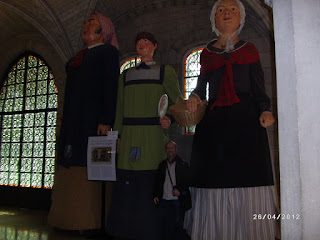Monday, April 30th, we headed for the western coast of France. Our first stop was at Cap Blanc Nez, which means white nose. It juts out into the English Channel. During the first World War 2000 fishermen died working to keep the area cleared of floating German mines.During World War II the Germans built concrete bunkers up and down the coast of France in order to prevent an attack by England and/or the USA.
The bunkers are everywhere! Though they proliferate along the coastline, they can be seen inland as well. They suddenly just pop up in the middle of fields. There's irony in the fact that some farmers have managed to make use of them in a variety of peaceful ways.
British planes took enough pictures to show just how well the Germans were dug into this area, which is why the invasion took place in Normandy rather than here.
Can you imagine what it would have been like to be dropped off on this beach to invade France? This is beautiful today, but you can be sure that bunkers are also in the cliff.
The area around here is a patchwork of greens, brown and bright yellow. The houses are probably cement block because they have stucco exteriors. I only saw a little brick, unlike further inland in the north and certainly not the stone of the south.
We could see England from here, but my better pictures of the white cliffs of Dover were taken at our next stop...Cap Gris Nez, or grey nose.
Fortunately, this was a clear day and even my little camera was able to pick up the coast of England.
A lot f the land is disturbed in ways that are obviously man-made.
Watching the sheep and lambs was comic relief. It was a large herd (I'm
not sure of the correct word for a group of sheep) and suddenly a farmer
appeared at the far end of the field. He called out "Allez, allez" and
all but 2 lambs went running for him. I don't know what they were
expecting, but it had to be comparable to brownies and ice cream because
I've never seen sheep move that fast! But there were those two lambs
all alone at the opposite end of the field. The farmer walked toward the
lambs, still calling, "Allez." Finally the two figured out that they
should join the other sheep. As they got near to the herd, their mother ran out to meet them, gave them a milk break and then all three followed the farmer.
The picture above is of Cap Blanc Nez taken at Cap Gris Nez.
There are several bunkers looking out from the hill to the left, but the sandy beach has been replaced by rocks.
For some reason, Cap Gris Nez was inundated with stupid black flies! After realizing that some people were upset because they had accidentally swallowed a fly, I kept my mouth shut and didn't breathe strongly through my nose either! The flies didn't bite. It was just that there were so many of them!
We also saw a bride and groom with their photographer.They were having their picture taken with great scenery as the back- ground. We also saw them later being photographed in one of those yellow fields!
Our next stop was in a nearby fishing village...only there aren't a lot of fishermen left. These small houses are now rented out to vacationers. Blue seems to be a favorite trim color and I even saw one house where the stucco was blue...
We ate at a lunch stand because it was cheaper. Everyone else loaded up on French fries. I had lettuce and tomato in my ham sandwich...and that's the closest I came to a vegetable today. (Dinner this evening was good, but it was chicken in a sauce served with rice and bread...no salad, no veggie.)
Then we headed for the aquarium. This picture is actually looking across the main street. There is one road behind this first row of buildings, but then there's the gentle cliff loaded with bunkers. There was no getting away from them!
Below is the other side of the main street, a wide beach right next to the aquarium. The aquarium itself was crowded and noisy. It had a few interesting exhibits, but it couldn't compete with Boston. For this I have been spoiled, though I did learn some things about the Mediterranean!




















































